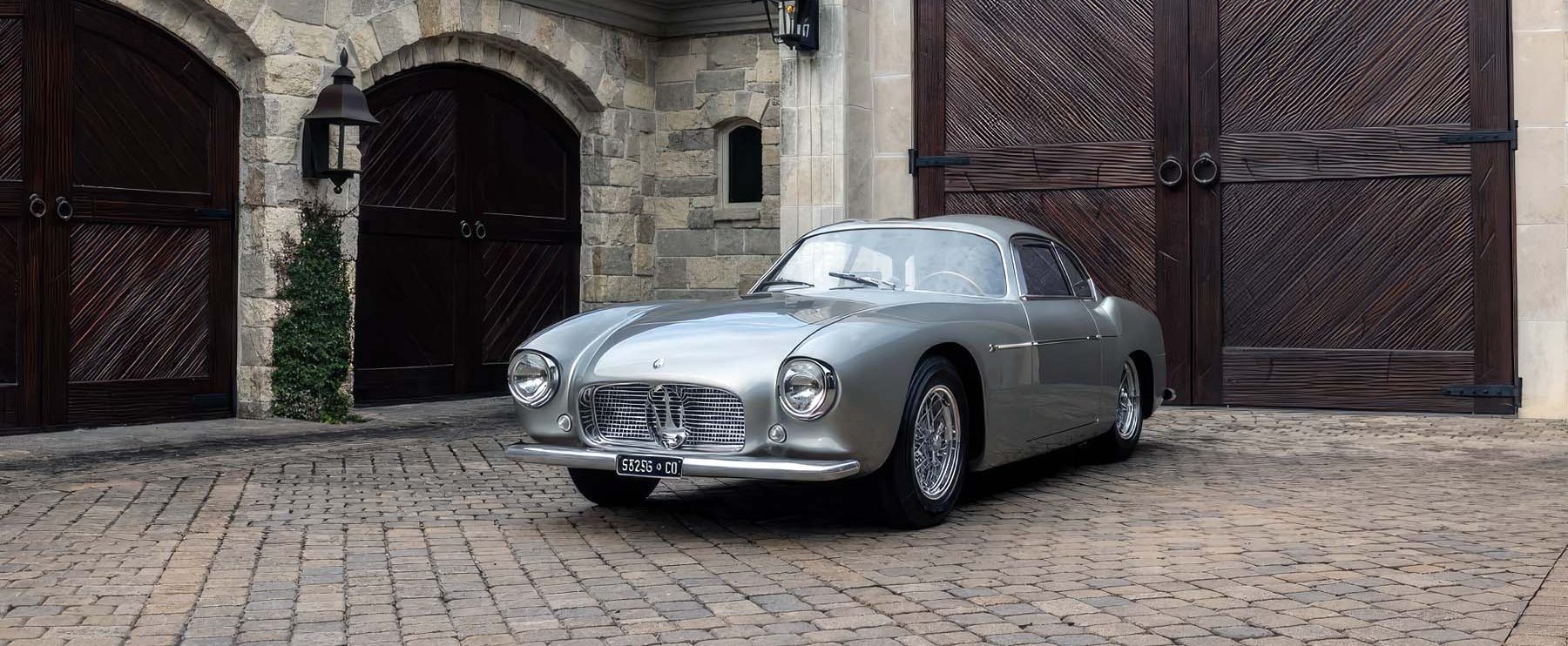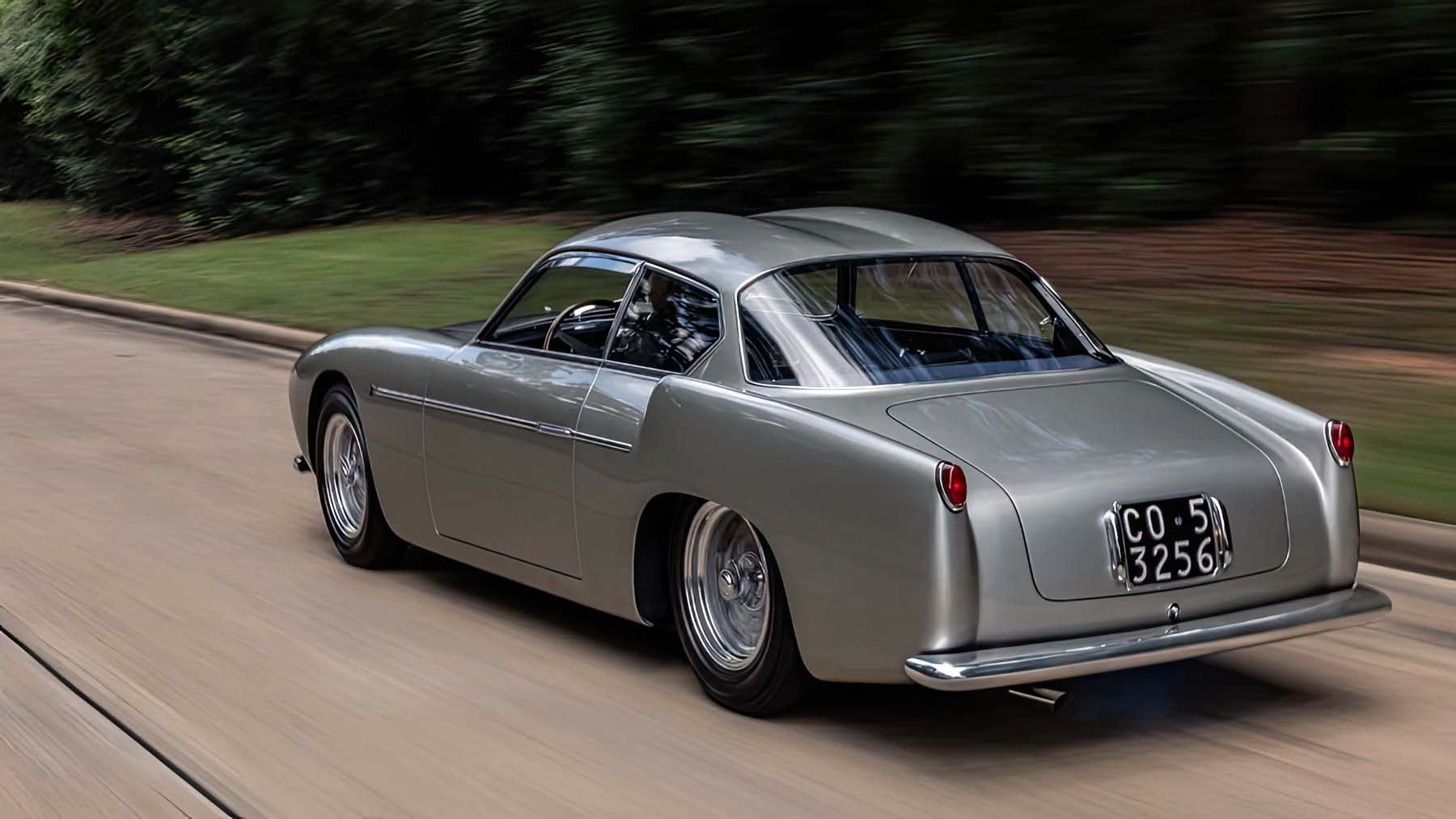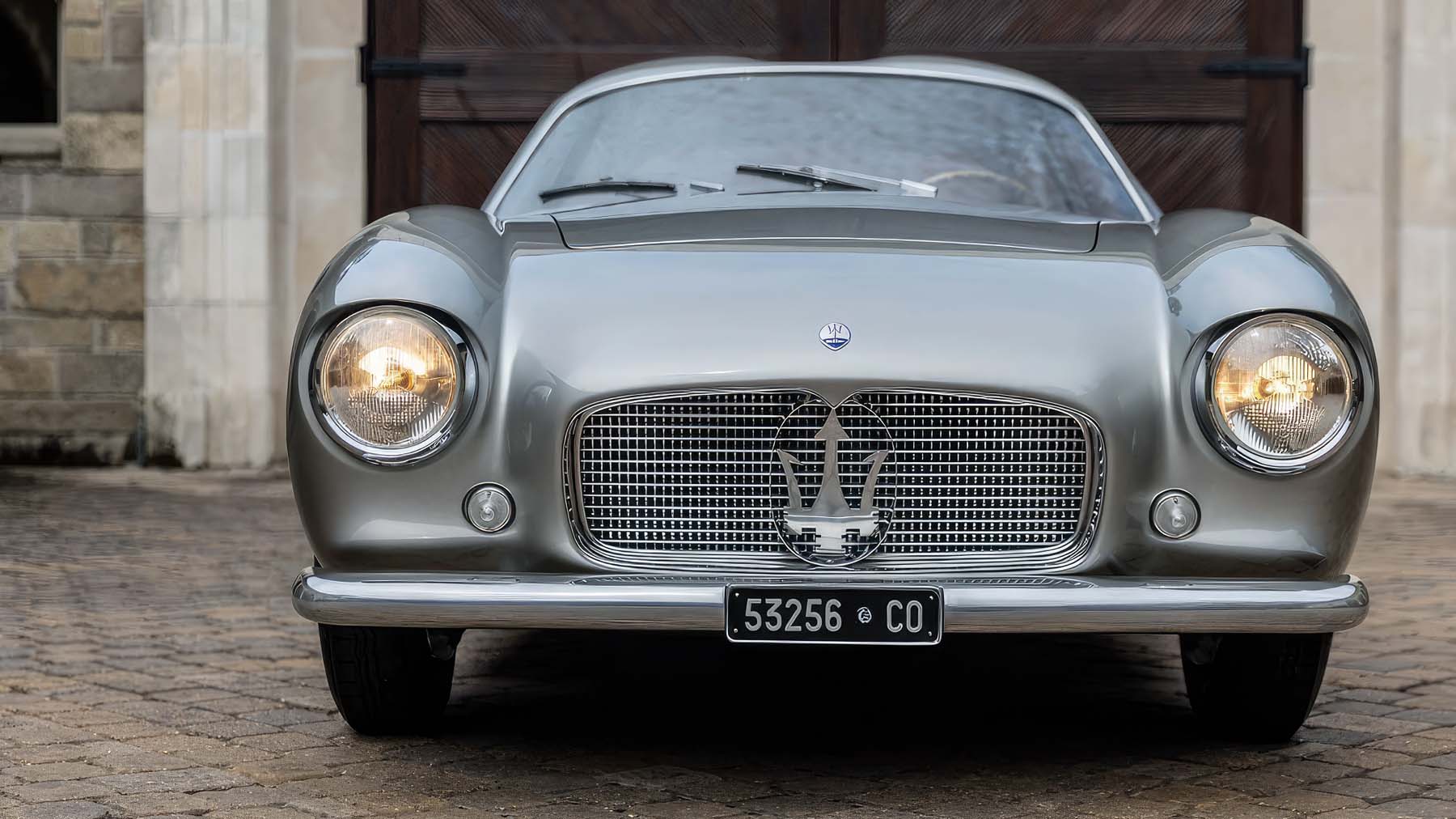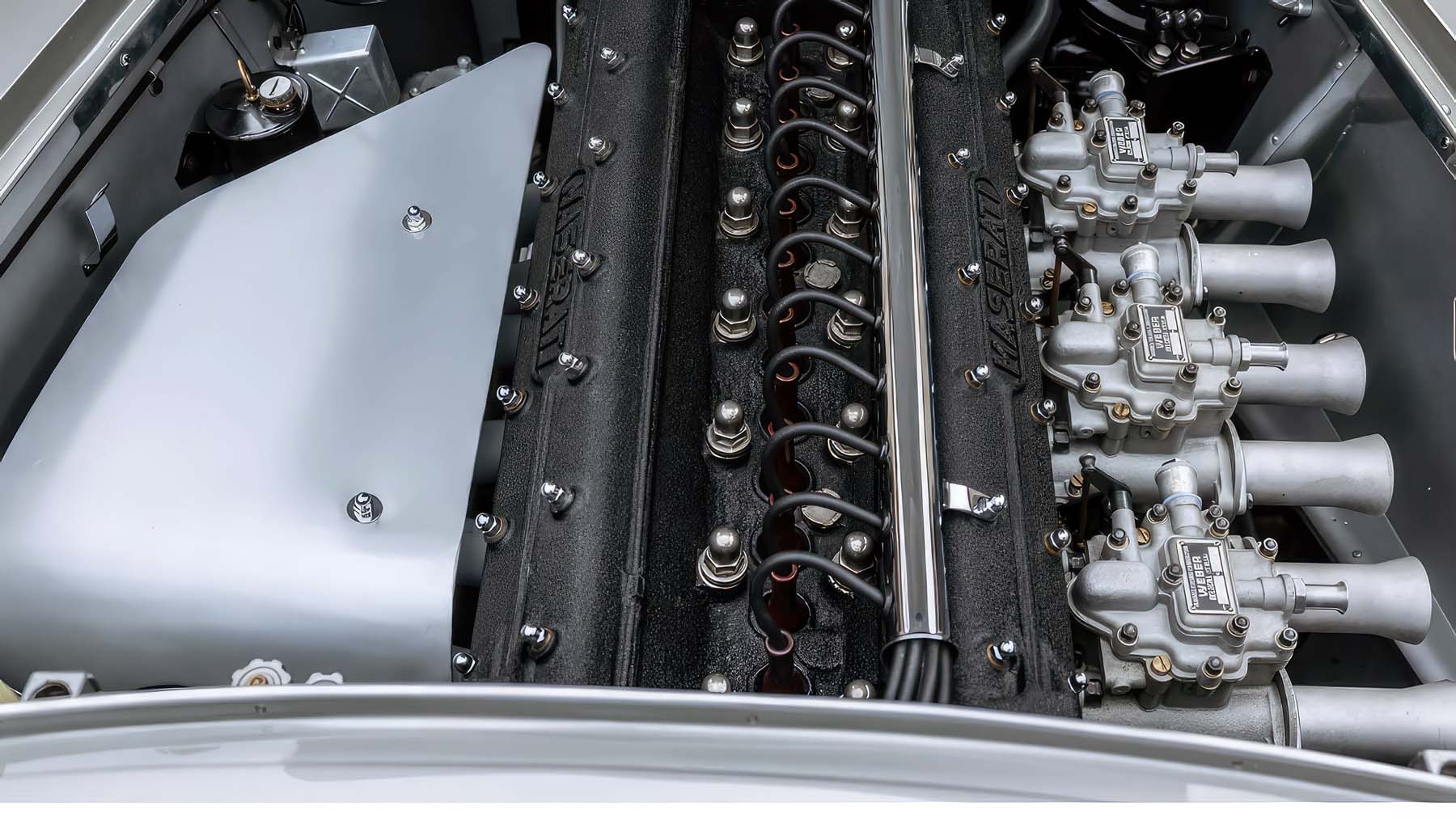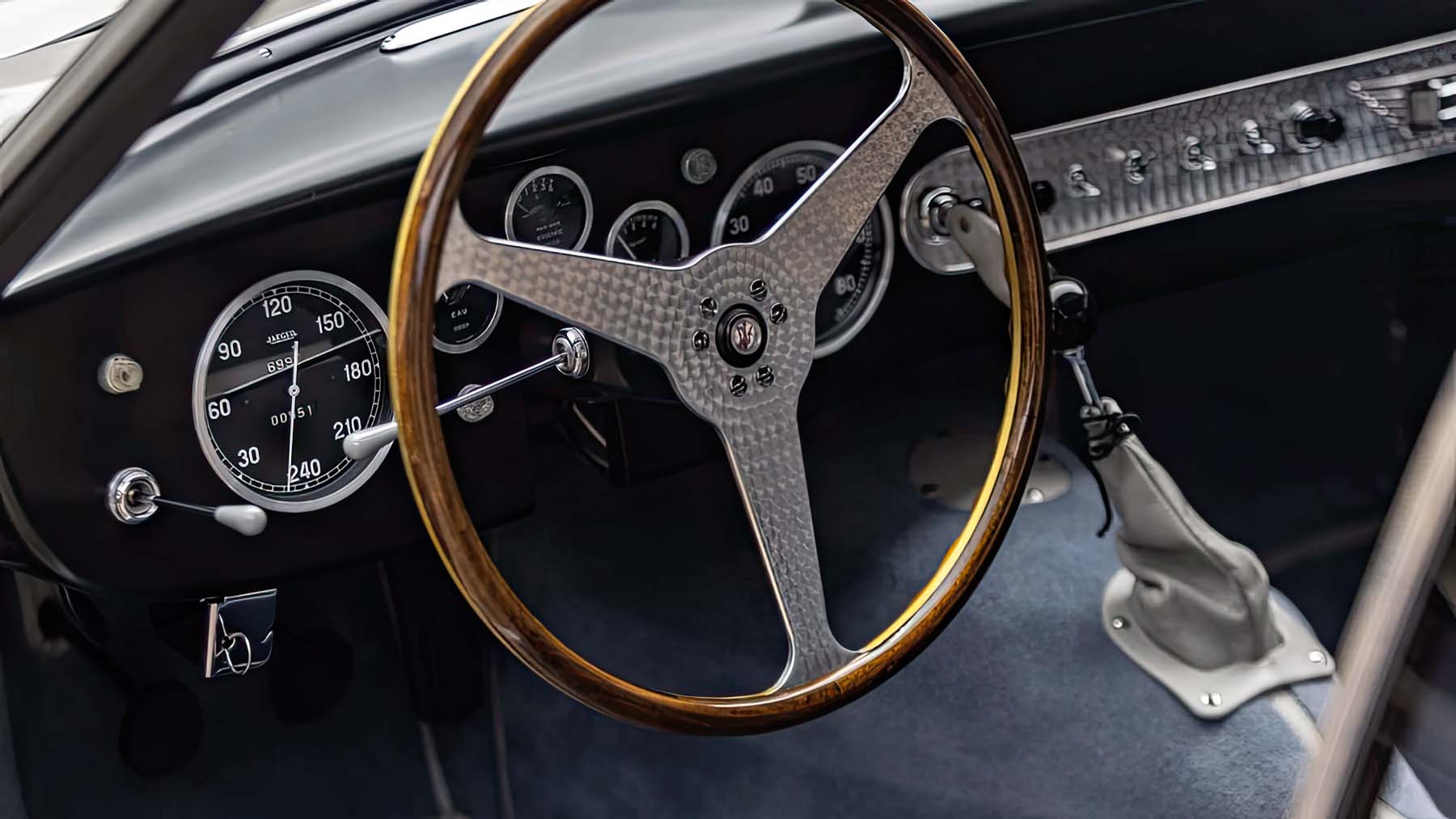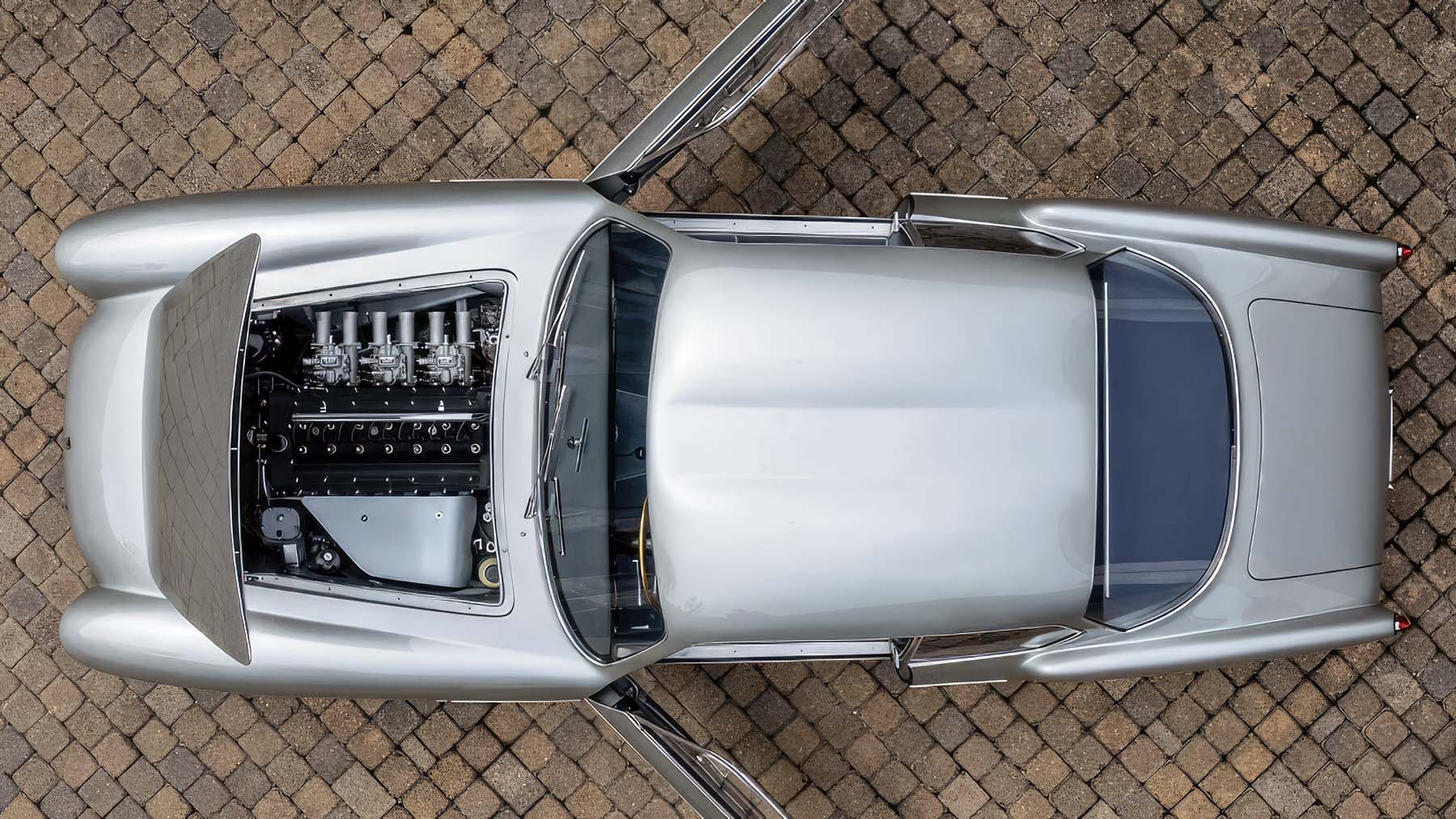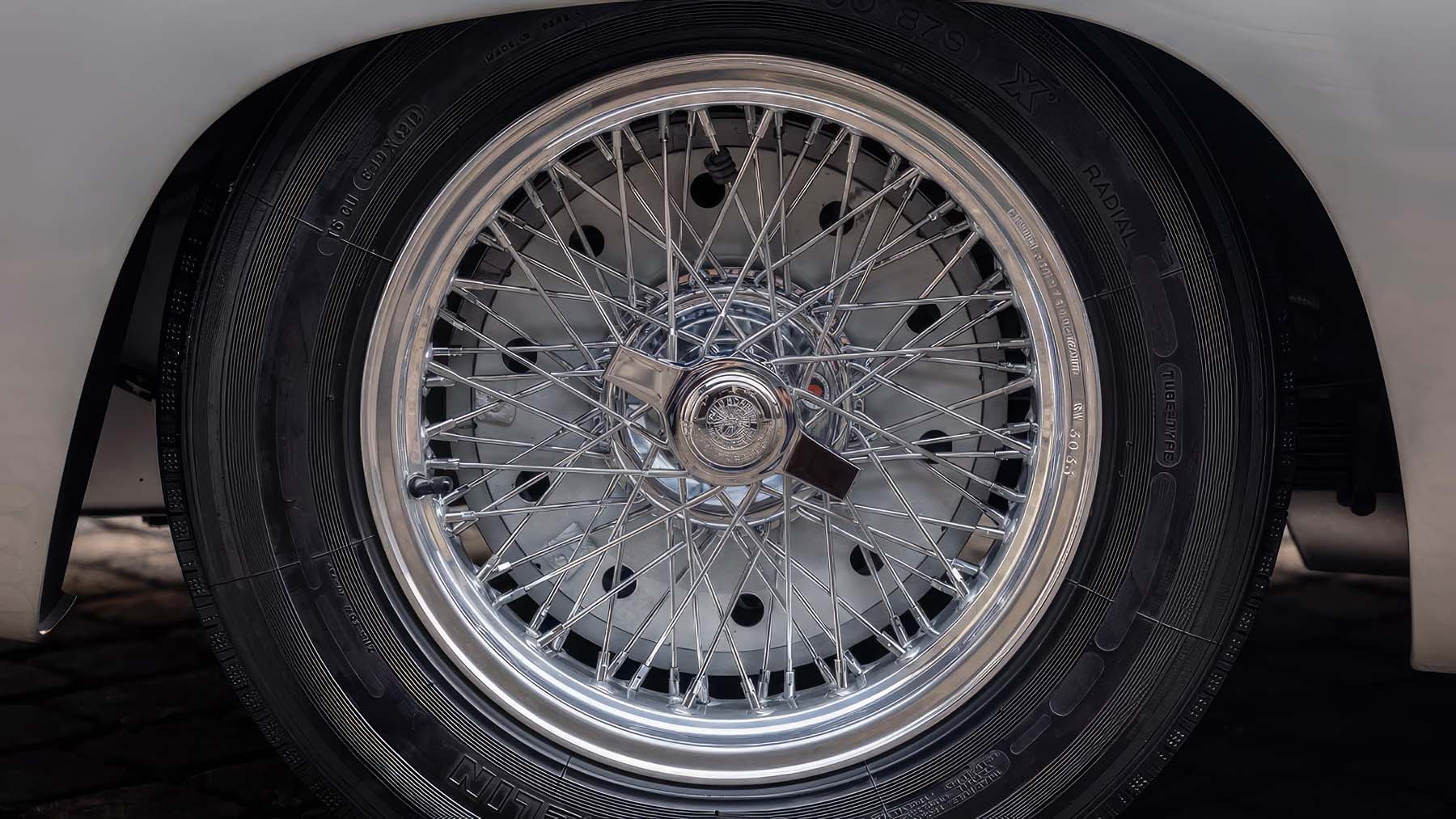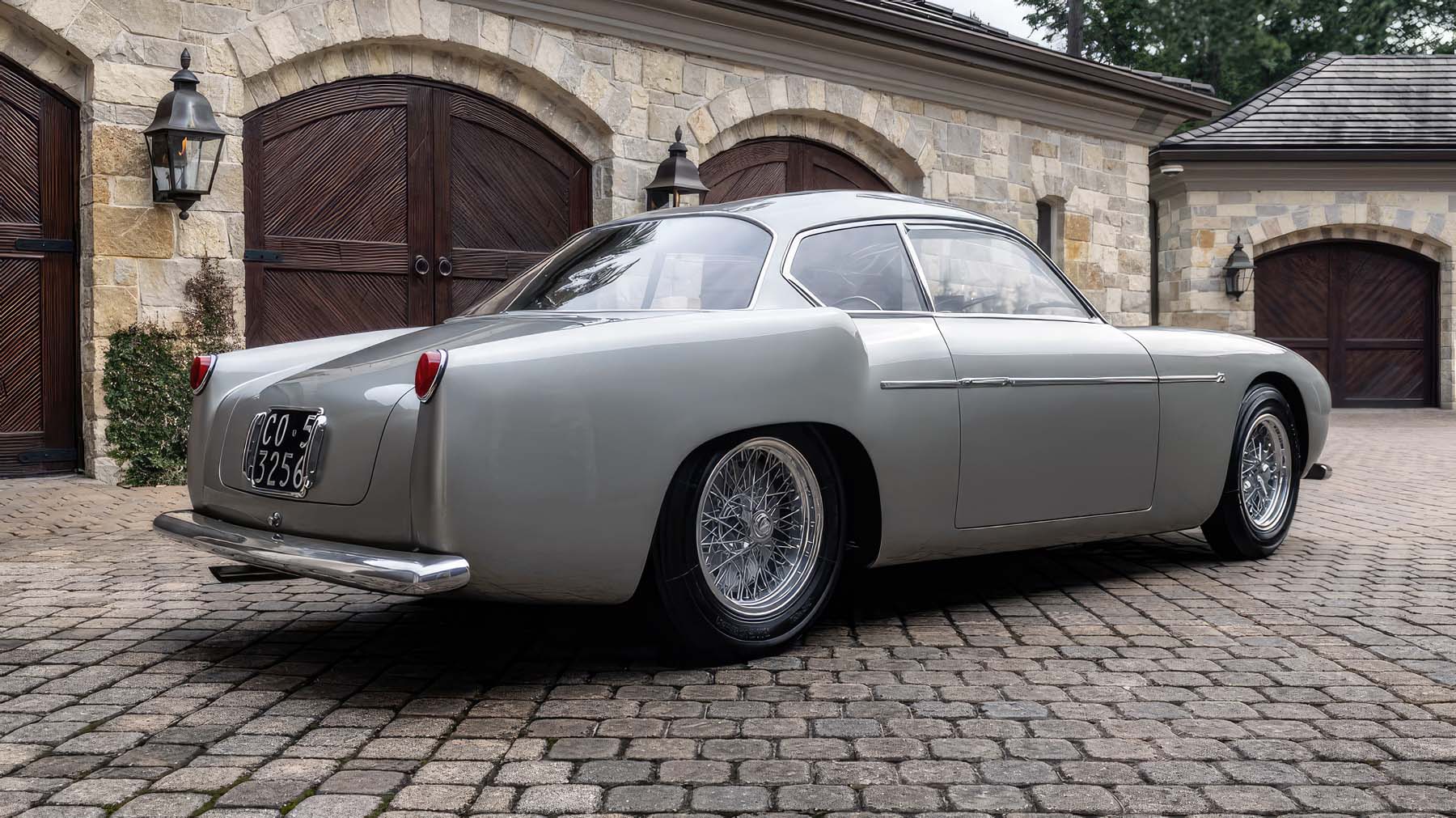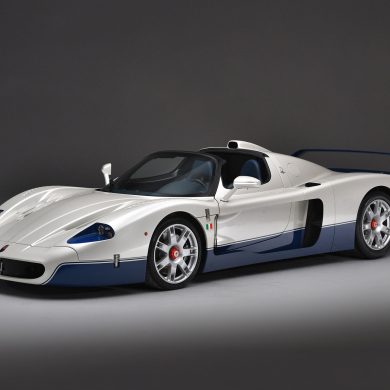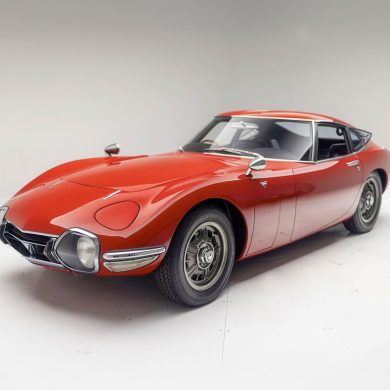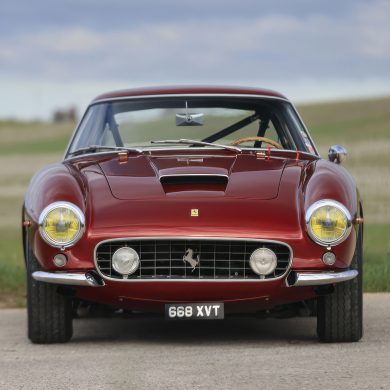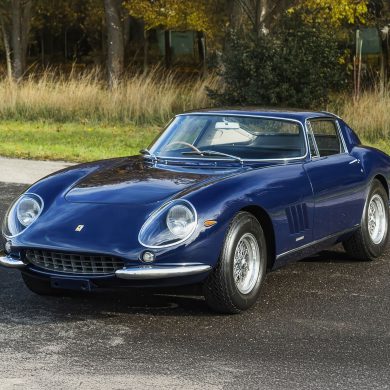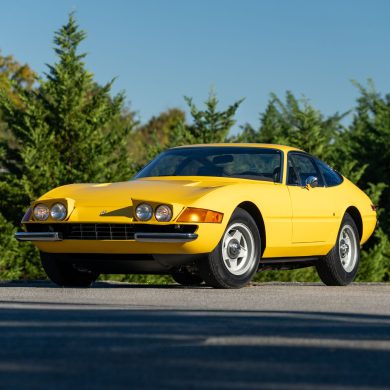From our friends at Broad Arrow Auctions comes one of the holy grails of post-war sports cars; the 1956 A6G/54 with a “Double-Bubble” Zagato roof.
Highlights of Chassis No. 2155
- One of 20 Zagato-bodied A6G/54 Berlinettas
- Likely the only A6G/54 with a “Double-Bubble” Zagato roof
- Raced in the 1956 Mille Miglia
- Restored in Italy, exquisitely refined by Paul Russell and Company
- Documented with digital copies of Maserati build sheets, factory and Zagato correspondence, period photography
- Comprehensively researched by Adolfo Orsi Jr. and includes an Orsi Report
- Class award at the 2009 Pebble Beach Concours d’Elegance, part of Maserati’s centennial celebration at the 2014 Pebble Beach Concours d’Elegance
- Eligible for all manner of top level vintage touring events including the Mille Miglia
Post-war “rarified air”
In the pantheon of coachbuilt, post-war sports cars, the Tipo A6G/2000 more commonly known as the A6G/54 sits in rarified air. Alongside Allemano and Frua, the famous Carrozzeria Zagato provided bodywork for the Gran Turismo with approximately 20 bespoke closed-roof Berlinettas produced by the Milanese design house during the three years of A6G/54 production. With a free-flowing, elegant Zagato design, this A6G/54 was clothed in lightweight aluminum bodywork, with the silhouette showcasing a purposeful form, its racing intentions, and, for this example alone, the trademark Zagato “double-bubble roof .” Hand-built with custom coachwork, minute details vary on each A6G/54 providing a unique opportunity to trace the lineage of a particular chassis number through historical photographs and documentation.
Inline-six
Of course, no post-war Italian GT is simply about its looks, no matter how alluring they may be. At the heart of Maserati’s GT Berlinetta was a 2.0-liter, dual overhead camshaft inline-six derived from Maserati’s A6GCS and A6GCM competition cars. Three Weber DCO/3 carburetors fed the 1,986 cc engine and with twin-spark ignition debuting in 1956, an increase in horsepower to an impressive 160 hp. Naturally, a lightweight and aerodynamic Italian GT with a race-bred engine would be designed with all the componentry to support it with coil-sprung independent front suspension with Houdaille lever-arm type shock absorbers, hydraulic drum brakes and Borrani wire wheels at all four corners.
Built for the 1956 Mille Miglia
Said to be the 17th of 20 Berlinettas built by Zagato, chassis number 2155, according to Walter Bäumer’s Maserati A6G 2000 Zagato was delivered to the coachbuilder on 15 April 1956. Completed as a 3rd Series Berlinetta, it was returned to the Maserati factory a month later, on the 15th of May. Built for Luigi Fornasari to compete in the 1956 Mille Miglia, it was delivered to Fornasari just days in advance of the start of the famous—and treacherous Italian road race. The owner of chassis number 2150, Fornasari was intimately familiar with the A6G/2000 series of cars. Bäumer recounts that Fornasari ran the car unpainted, featuring all the raw hallmarks of its hand-formed aluminum body, with a temporary rear window registration (BO59891) from the Maserati factory either due to the narrow timeline before its first race, or possibly that chassis number 2155 was loaned to him by the factory. Along with his co-driver Gianfranco Roghi, Fornasari left the starting line in Brescia with start number 311. Hopes for a well-placed finish were dashed on the rain-slickened roads of Ravenna with an accident that resulted in the brand-new Maserati landing on its roof and a subsequent DNF. With all aboard spared serious injury, the Gran Turismo was returned to Zagato to be repaired, this time painted in Silver Metallic with a smaller radiator opening, lowered headlights, a unique strip of alloy trim running from the back of the front fenders to the door handle—the only known A6G/54 Berlinetta from Zagato to receive this treatment and a detail that would remain with the car until today. A period photo included in the car’s history file shows Fornasari’s son standing in front of the repaired Maserati with its unique double-bubble roof profile in full view.
Hill climb competition
Later that year in June, according to the Orsi report and Maserati factory paperwork, also on file and available for review, the car was sold to Roberto Federici based in Rome. Less than a month later the car was purchased and registered by Gianfranco Peduzzi. By September 1957 the Maserati began competing again, this time in smaller road races and hillclimbs. On most weekends throughout the racing season the European Alps hosted numerous hillclimb contests and, with lower entry and maintenance costs, they proved extremely popular even if they were inherently more dangerous than traditional circuit racing. Bäumer’s book indicates that the Aosta-Gran San Bernardo Hillclimb was its return to racing on 1 September with a start number 48 and entered by Giacomo Moioli of Verona, who commonly raced under the pseudonym “Noris.” Moioli was at the wheel once again later that month at the Pontedecimo-Giovi Hillclimb with start number 306, finishing fourth in class, while its final race of 1957, chronicled by the Orsi report indicates that Natale Gotelli was entered to pilot 2155 at the Trieste-Opicina Hillclimb on 6 October 1957 but was classified with a likely DNS. The report also contains correspondence between Zagato and Maserati on behalf of Peduzzi regarding specific engine technical details, likey surrounding a fresh engine break-in.
Upon completion of the repairs and while at Zagato, the car was taken for a shake-down by none other than Gianni Zagato, who was involved in a high-speed accident while performing his tests. Subsequent correspondence between Zagato and Maserati beginning in November of 1957 is recorded by Orsi, regarding repairs to the car and some back-and-forth over the specifics and costs. Zagato smartly capitalized on the situation by utilizing chassis number 2155 as a design study for Maserati’s upcoming 3500 GT. Period color photographs on file show the new design, revised from previous iterations and proudly on display. By the summer of 1958, the car was racing again with Natale Gotelli at the helm at both the Bolzano-Mendoa and Trento-Bondone hillclimbs. In 1959 the Maserati was entered in two circuit races at Monza, both the Gran Premio Lotteria on 28 June, finishing 11th in the GT class, and in the Coppa Intereuropa on the 13 of September where it did not finish. A fine third in the GT class at the Pontedecimo-Giovi hillclimb rounded out the season and its racing career.
Restoration
Over the next decade, Adolfo Orsi records a successive chain of Italian owners before the car was acquired by Enrico Bertotto likely in the late-1960s. By 1977, a letter from Zagato to Maserati recounts an inquiry by the current owner to restore it to the original state with a request to Maserati for assistance in the matter. In 1984 photographs document a restoration with a color change to red with covered headlights and over the next decade, and until the turn of the century it appeared at concours, exhibitions, and in print in this configuration. Sold in Paris in the year 2000 to heralded Maserati collector John Bookout of Houston, Texas, he returned the car to Modena for a return to its 1958 configuration under the guidance and control of Adolfo Orsi Jr. During the restoration a number of Modanese specialists participated including Carrozzeria Autosport, Carrozzeria Cremonini, Officina Giuseppe Candini, and Interni Auto Maieli handing the bodywork, paint, mechanicals, and upholstery respectively. By 2005 the restored A6G Zagato was displayed at the prestigious Concorso d’Eleganza Villa d’Este. Remarkably, after its restoration and while still in Europe, Gianni Zagato was reunited with the car, likely seeing it for the first time since 1958!
Ownership trail
In 2008 Bookout parted ways with the car, passing it to a collector also based in Texas. As documented by over 140 pages of invoices and receipts, the car was entrusted to the experts at Paul Russell and Company of Essex, Massachusetts to further refine both the cosmetics and mechanicals. Beginning in January 2009, work began at Paul Russell to prepare the car for the Pebble Beach Concours d’Elegance and its highly discriminating judges. Over the next eight months the craftsman at Paul Russell’s shop delved into all areas of the Maserati, with particular focus on the mechanicals and detail items unique to the car as well as cosmetic finishes that are critical to a high score at Pebble Beach. The fastidiousness of their work was evident in a well-earned Zagato class award. In addition to Villa d’Este and Pebble Beach this Zagato Berlinetta has been shown at The Quail in 2010 and Cavallino Classic in 2013, where it won two awards including Finest GT, later returning to Pebble Beach in 2014 as part of Maserati’s centennial celebration during the Concours d’Elegance festivities.
Retained within the consignor’s collection since 2008, this Maserati A6G/54 Zagato Berlinetta, one of only 20 Zagato bodied variants built and the only known example built with a double-bubble roof, is an expertly restored and highly decorated example. With period race history, including the famous Mille Miglia in 1956, circuit races at Monza, and numerous hillclimbs well documented in print by Walter Bäumer and a comprehensive report by Adolfo Orsi Jr., its colorful, outsized history makes it a compelling choice for one of the most unique and interesting Maseratis to emerge from Modena and Milan.


